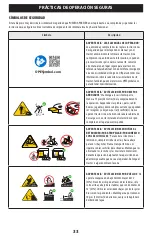
19
PRODUCT CARE
• Excess lubrication can become collection sites for debris.
Immediate repair and cleaning up excess lubrication can help
reduce fire hazards.
• In addition to cleaning the riding mower before operating
and storing, do not attempt to mow unusually tall grass
(10 inches or higher), dry grass (e.g., pasture) or piles of dry
leaves. Dry grass or leaves may build up on the riding mower
deck presenting a potential fire hazard.
Lubrication
DANGER
Bearing failures and overheating can result in
fire. Always follow the instructions in this manual
regarding lubrication locations and intervals. Contact
your authorized dealer with any questions about the
lubrication locations and intervals or any unusual noises
coming from any areas a bearing may be located.
WARNING
Before inspecting, cleaning, or servicing the riding
mower, power off the riding mower and remove the key.
FRONT AXLES:
Each end of the riding mower’s front pivot bar may be equipped
with a grease fitting. Lubricate with a grease gun after every 25
hours of operation.
REAR WHEELS:
The rear wheels should be removed from the axles once a season.
Lubricate the axles and the rims well with an all-purpose grease
before re-installing them.
PIVOT POINTS & LINKAGE:
Lubricate all the pivot points on the drive system, parking brake
and lift linkage at least once a season with light oil.
NOTE:
It is not necessary to grease the steering pinion/sector
gear interface. Doing so will allow dirt to accumulate and can
affect steering performance.
ADJUSTMENTS
WARNING
Before making adjustments, power off the riding mower,
and remove the key. Protect your hands by using heavy
gloves when handling the blades.
NOTE:
Check the riding mower’s tire pressure before performing
any deck leveling adjustments. Refer to Checking Tire Pressure in
the Set-up section for information regarding tire pressure.
Adjusting the Deck
LEVELING THE DECK (FRONT-TO-REAR)
It is possible to adjust the pitch of the cutting deck. The front
of the deck should be between 0 inches (level) and 1/4 inch
(6.4 mm) lower than the rear of the deck. Adjust if necessary
as follows:
1. With the riding mower parked on a firm, level surface,
place the deck lift lever in the middle position and rotate
the blade so that it is aligned with the front and rear of the
riding mower.
2. Measure the distance from the front of the blade tip to the
ground and the rear of the blade tip to the ground. The end
of the blade facing the front of the deck should be between 0
inches (level) and 1/4 inch (6.4 mm) less than the end of the
blade facing the back of the deck. Determine the approximate
distance necessary for proper adjustment and proceed, if
necessary, to the next step.
3. Locate the flange lock nut (a) on the front end of the PTO lift
rod (b) (Figure 16).
a. Tighten the flange lock nut (a) to raise the front of
the deck.
b. Loosen the flange lock nut (a) to lower the front of
the deck.
a
b
Figure 16
Parking Brake Adjustment
If the riding mower does not come to a complete stop when the
brake pedal is completely depressed, or if the riding mower’s rear
wheels can roll with the parking brake applied, the brake is in
need of adjustment. See your authorized service dealer to have
the brake adjusted.
Neutral Adjustment
If the riding mower creeps forward or rearward when neither
the forward nor reverse pedal is depressed, contact your local
authorized dealer to have the neutral setting properly adjusted.
Seat Adjustment
Refer to the Set-up section of this manual for seat
adjustment instructions.
Summary of Contents for 33 27JD Series
Page 78: ...NOTES NOTAS NOTES ...
Page 79: ...NOTES NOTAS NOTES ...


































![Whirlpool [12:36:03] ?????????????????: GC900QPPB Use & Care Manual preview](http://thumbs.mh-extra.com/thumbs/whirlpool/12-36-03-gc900qppb/12-36-03-gc900qppb_use-and-care-manual_437149-01.webp)













